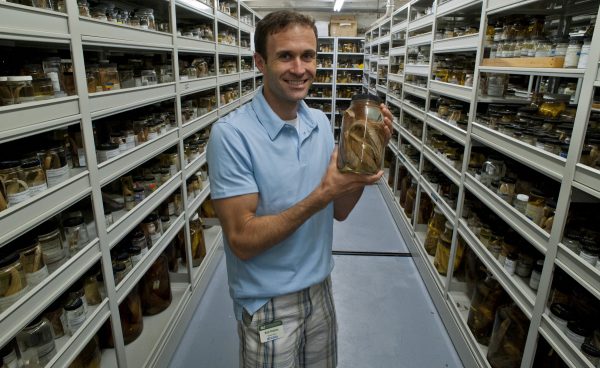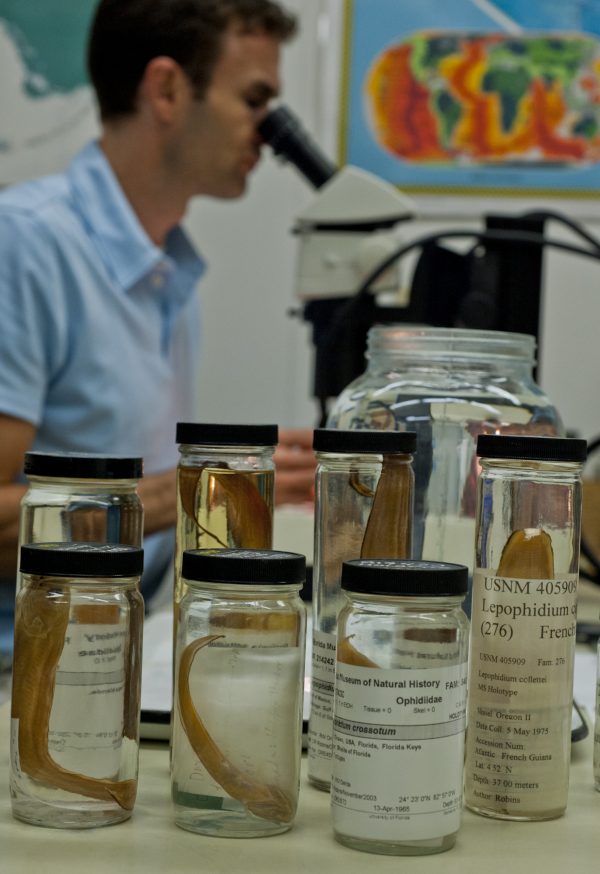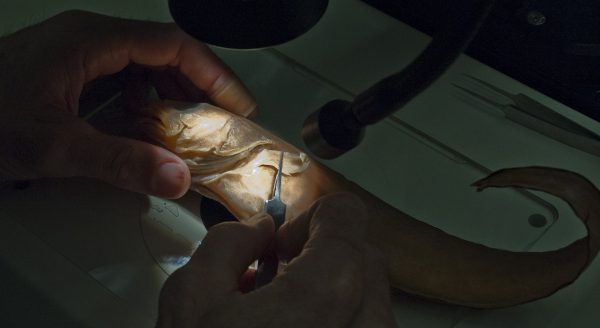For Florida Museum of Natural History collection manager Rob Robins, biodiversity is something of a family theme.

Florida Museum photos by Jeff Gage
Florida Museum photo by Jeff Gage
With his father a renowned ichthyologist, his mother an ichthyologist who sacrificed career for family and his wife a wildlife biologist, Robins has always been surrounded with the wonders of animal life. As a child, he witnessed marine discoveries made by his father, C. Richard “Dick” Robins and grew up in a home fabled among friends and relatives for the diversity of living creatures cared for there by his parents. Today, his adult life is very much a continuation of what he was introduced to as a child: A workplace filled with a myriad of preserved fishes and a host of living animals waiting for him at home, including many pet snakes and fishes.
As collection manager of the Florida Museum’s ichthyology division, Rob Robins is tasked with identifying, labeling, sorting and storing thousands of marine and freshwater specimens that come through his office in Dickinson Hall. It was an ideal setting for conducting recent research that enabled his father’s monograph on cusk-eels to be published in the Florida Museum of Natural History Bulletin Sept. 11, 2012. His wife, museum volunteer Mary Brown, is also a co-author.
The 60-year study describes eight new species of one of the least-studied groups of cusk-eels – bony fishes distantly related to cod. Although abundant and widespread in the Americas, the fishes in the genus Lepophidium have previously been poorly known to biologists.
“This study is important to me as an ichthyologist because it’s another contribution to our understanding of the diversity of fishes,” Rob Robins said. “But it’s important to me personally because it’s helping my father to complete a work he started when he was younger than I am now and it’s on a group of fishes that was a big part of his life’s work. Collaborating with my wife on it was just an added bonus – she really helped to get the ball rolling.”
In addition to describing the new species, the study includes new descriptions of all members of the genus and elevates two sub-species to species, bringing the number of Lepophidiumspecies to 23. The research included observations of the fish in the wild, X-rays of their internal anatomy and close examination of thousands of museum specimens. The study provides data for better understanding how disasters like the 2010 Gulf of Mexico oil spill impact biodiversity and the environment.

Florida Museum photo by Jeff Gage
“With the recent Gulf of Mexico disaster, one of the first things that people started asking was what impact was had and on what animals, and a lot of biologists said, ‘We don’t know all the animals that are in the Gulf of Mexico because the area hasn’t been studied enough,’ ” Rob Robins said. “A number of these species are from the Gulf of Mexico, including some of the new ones, and this paper brings us closer to our ultimate goal of cataloguing the diversity of life so that when we need the information, it’s available.”
Lead author Dick Robins, University of Kansas curator emeritus, completed much of the fieldwork and collected many examples of cusk-eels as a professor of marine science at the University of Miami. Miami’s fish collection was later transferred and is now part of the Florida Museum’s ichthyology collection, one of the five largest in the nation.
“I think it’s amazing that there is a group of fishes that is really common in shallow water that had so many undescribed species,” Dick Robins said. “It just shows the state of the art is really poor and unfortunately, I think it’s really typical. I’d hate to hazard a guess about how many undescribed species of fish there are in really shallow waters, but people don’t seem to work on them that much.”
The genus Lepophidium includes smaller species of cusk-eels that live on the Continental Shelf, from shallow coastal water to about 600 feet deep.
“Since these are soft-bottom fishes and some of these occur in shallow waters, you’re dealing with man’s effect on the environment, what pollution does to some of these environments and how it affects the animals that live there,” said California Academy of Sciences research associate Robert Lea, a marine biologist who specializes in another genus of cusk-eels. “Some of these are going to be Gulf of Mexico species and probably many of these are going to be indicators of environmental quality also.”
Because they are benthic, meaning they live near the bottom, and burrow in sand, cusk-eels are particularly difficult to collect, Lea said.
“This is a group that we’ve needed additional knowledge on, and this study provides a tremendous amount of information for people studying soft-bottom fishes in the Americas,” Lea said. “This is a milestone work because it’s a lifelong study and it answers a lot of questions. It’s the end of a chapter for that group of animals.”
Cusk-eels are plainly colored, typically with a beige body and some degree of black pigment in the fins. They also have a rostral spine, a sharp point found on their snout. Major differences in the cusk-eels include features of their internal anatomy, such as number of vertebrae or gut color. Fin ray counts are also important for distinguishing the various species.

Florida Museum photo by Jeff Gage
“This is not a case of just working with specimens in a museum – it’s important to know these animals and where they live,” Dick Robins said. “I think it’s important that we know about the animals that we share this planet with.”
Cusk-eels may reach 6.5 feet in South America, where they are an important food source in some regions, but the Lepophidium species, which typically do not exceed 1 foot, are generally too small for human consumption, researchers said. Dick Robins became interested in studying cusk-eels in the early 1960s because he encountered so many undescribed species, he said.
“This was a group of fish that turned me on at some point and nobody else was working on them,” Dick Robins said. “The more I worked, the more undescribed species I found. So I just got more and more involved with it. I’m very happy to have this opportunity to bring it all together in this paper.”
“This is my final paper on the group and I wouldn’t have gotten it done without my son and daughter-in-law’s help.”
Learn more about the Ichthyology Collection at the Florida Museum.